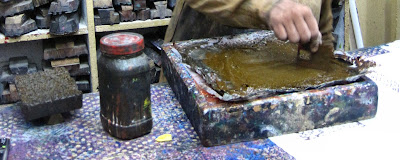Decoupage being the art of
cutting and pasting, I begin with a set of cut-outs. Having worked for over a
decade, I now have envelopes of photographs (my own), and even ready-cut motifs,
which are often left over after a project is complete, and which serve as
inspiration for the next. Although I don’t repeat designs, I do use same or
similar motifs in different projects. For instance, the Islamic tile motifs
have been used many times, but the overall effect is different as I constantly
add innovations, the most recent being carving into the surface of the project
(see albums of past work for examples).
Many of my decoupage projects are
commissions. They are very much an interactive process with the client, with
whom I discuss design and colour scheme, and to whom I show the cuttings I have
on hand. In the case of the chest of drawers, the client and I began with the
set of cuttings shown in the first photograph of the enclosed slideshow.
Much of my decoupage is based on
photography. Using semi-professional computer software, I alter colours and contrasts, or
even change the colour scheme to black and white or sepia. I also crop pictures
or cut and paste them to make different combinations. The border motif used on
the chest, which is composed of white and peach flowers on a blue-turquoise
ground, began as a single motif, made into a field of repeats by cutting and
pasting. The resulting frieze was printed in two sizes. The full border was
used on the front and sides, while a wider version was cut into half and used
for the top. Similarly, some of the motifs used to embellish the drawers began
life as half-motifs which were then mirrored to create a full motif, and blown
up to make large versions.
I like to add to decoupage by
using lino cuts. I already have a library of blocks in varying sizes, from very
narrow 1 inch borders to five and six inch single motifs. But for this project,
the most detailed large project that I have made so far, I cut a new set of
blocks. All of them were inspired by motifs from the frescoes in the Wazir Khan
Mosque in Lahore.
Cutting paper as well as lino takes
several days, but that’s only the preliminary stage. It’s followed by priming and
colouring the surface, in this case wood. For this chest of drawers, I painted
the wood in solid colours where I planned to print full borders, and stained it
with a wash in areas where I wanted the colour to fade into the natural wood. These
areas were sanded back after they dried, to reveal the grain. I then applied
sections of silver leaf in areas where I planned to use lino blocks. These were
printed with pomegranate and lotus motifs. My lino prints usually feature
double printing. I may do a double roll of colour so that the block is printed
in two shades, and when it’s dry I may go over it with a third colour, or with
a similar colour and a different block. For instance, the edges of the pomegranate
and lotus motifs were overprinted with the border motif, using the same shade, to
create a layering of motifs and textures. The border motif itself was printed
with a double roll of white and pink, then partially over-printed in copper to
allow the original colours to show through. As the design evolved, I used the
copper colour and the border motif on the drawer fronts and the sides of the
chest, using copper and silver inks. This printing is largely to create texture,
and the motifs are only partially printed.
The front of the chest was
decorated with decoupage in the vertical sections, and lino printing in the
horizontal ones.
As with most art work, the
process is an evolutionary one in which I keep looking at the work to see where I need to add or subtract. The drawers evolved after I finished the
borders and lino printing on the front frame. Initially I planned to leave then
unpainted, with a defined border in the groove on the front of each drawer. But
when I assembled the piece after printing, I realized it would be better to
give them a stain which began at the outer edges and faded towards the inner
edges and the centre motif. The little silver rosebuds were very much an
afterthought, to ‘lift’ the copper printing on blue-turquoise, and they were
repeated on the top and sides, to bring the various, very diverse elements
together.
I seal the decoupage myself using
a water based varnish, which is applied in several thin coats. This is followed
by shellac. This is done by my assistant, as I now find varnishing such large
projects difficult to handle alone. Shellac turns the wood darker; it also gave
the turquoise a slightly yellowish tone.
What I aim for finally is a
floating effect in which each layer is visible, achieved by varnishing the work
over and over again.
here is the link to the slideshow that documents the process:
link to slideshow documenting the process


















































